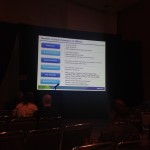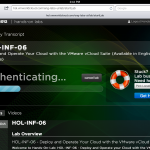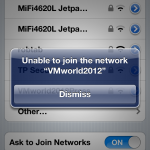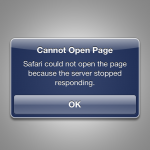| The day started with a less dramatic keynote than Monday. Steve Herrod, VMware CTO, gave an update on end-user computing. I like the prospects of Operation Horizon–the promise of delivering the user a single place to go for all their apps, desktops, and data. Last year Steve demoed mobile OS virtualization on an Android device. That was pretty slick, but it was for Android only. This year he demoed some interesting developments in the iOS space. While the Android solution is still more impressive and elegant, at least VMware was able to demonstrate a commitment to developing for iOS, since that is what most customers want. The biggest eyebrow-raiser for me is the integration of XenApp into Horizon. VMware is going head on at Citrix in the desktop virtualization space, and other fronts: cloud file storage, user portal, self-provisioning… It is interesting that they seem to be throwing in the towel on application virtualization. Not sure if they are running into too much resistance on the electronic medical records front, where hospitals seem to be largely committed to XenApp or what. Or, if they are having trouble innovating with respect to ThinApp. In any case, it is an interesting development. Personally, I’m not sure I want to support infrastructure for both View and Xen if I don’t have to.
Takeaways from session vCAT 3.0: Architecture to Implementation in 5 Easy Steps:
First of all, total false advertising. I was intrigued by the notion that there were five easy steps to architecting anything, much less VMware. As I suspected it wasn’t easy. It turns out there are five steps, and these are essentially the same as any project management plan–five very involved steps that are probably easy enough for someone used to a complex project management process. But anyhow, there are some important take aways.
- vCat 3.0 is the latest release of a toolkit for VMware architects to do their own designs… methodologies and considerations for building and deploying VMware technologies.
- Use the VMware implementation examples docs; these provide real examples of VMware designs.
- Get vCat.
Now for the arguably geekiest session yet, Virtualizing Oracle for Disaster Recovery with Data Guard and VMware vCenter Site Recovery Manager. Takeaways:
- Use SRM to failover web and app vms, but use DataGuard to failover the databases to the secondary servers. Okay, but are you going to explain why? I think what they are saying is that it is preferred to use DataGuard for database failover rather than SRM as DataGuard is designed specifically to avoid database corruption whereas SRM is not. Good point. Touché. King’s to you.
- Don’t use VMware vShpere Replication as it does not currently deliver synchronous replication. In fact, it does not guarantee less than a 15 minute RPO. So, some data loss is virtually guaranteed.
How about benefits of virtualizing Oracle?
- Performance is not an issue.
- Server consolidation
- Simplify deployment
- More…
Daily Fails. So today had some fails that warrant mentioning:
- Yesterday when Steve Herrod mentioned that they would be live polling the audience during Tuesday’s keynote I was doubtful that it would work. If you’ve ever been to a large concert or sporting event you know how difficult it can be to make a call, send a text, or check-in on Facebook. Now, VMware is not a wireless networking provider, but they should know if you get 20,000 geeks together in one room you are going to have 40,000 wireless devices. Consequently, just getting on wifi was tricky. Navigating to the polling website was darned near impossible. Deep in the bowels of the Moscone, AT&T’s 3G suffered from the same problem. I was able only to respond to two of the polls and that with much effort. All of that work that your device does to try to connect, try to send, resending… It kills your battery while you get next to nothing done. During the keynote, I depleted half my battery. I don’t know who is providing this conference’s wifi, but i suspect they aren’t using the latest advances in this space. There are a number of companies innovating in this wireless space–large scale extremely high user density. What I’m talking about is using many radios, an array of multiple uni-directional antennas, and pairing devices to the right radio, frequency, and data rate, based on the profile of the device. I’m thinking of vendors like Xirrus (disclosure: I’ve gotten nothing from Xirrus for this mention, though if they wanted to give me something, I’d take it). Ultimately, this lousy ability to respond to the polls probably doesn’t matter. If you have a basic knowledge of statistics, you understand that you only need a relatively small sample size to have a reasonably accurate poll–not good enough for voting, when every vote should count–but good enough for a poll. So, my complaint isn’t about the validity of the poll, but about the user experience. The irony was not lost on me, that the audience participation aspect of this keynote about end-user computing/customer experience pretty well stunk.
- Yesterday Steve promised that all five of VMworld’s platinum sponsors would be delivering four minute live demos. And that we would be able to vote for the best in an American-Idol-America-chooses fashion, hence the need for live polling. NetApp ultimately won the competition, but I dispute that outcome. As I’ve already discussed I don’t dispute the validity of the poll. My beef with respect to the outcome is not in regard to voter fraud, or some such thing. NetApp didn’t satisfy the criteria of the competition. Not only were the polls supposed to be live, but also the demos. Of the five competitors only EMC provided a live demo. The others used video demonstrations. HP was the sneakiest. Their presenter was kind of miming the mouse movements during the video. Not sure if it was intentional. Seemed that way at first, but later it was obvious he wasn’t doing it live. In the case of Dell, the mouse movements and screen refreshes were faster than humanly possible. Cisco didn’t even do a demo, but a song (lip sync’ed) and essentially a PowerPoint. When you advertise a live demo, deliver a live demo, not a sales presentation. So, my kudos go out to EMC who actually did a demo–of a file recovery–in nearly the allotted time. (disclosure: the University of Oklahoma is an EMC customer, but we get storage from a lot of different vendors; EMC gave me nothing for this mention).
|
|
 



|




